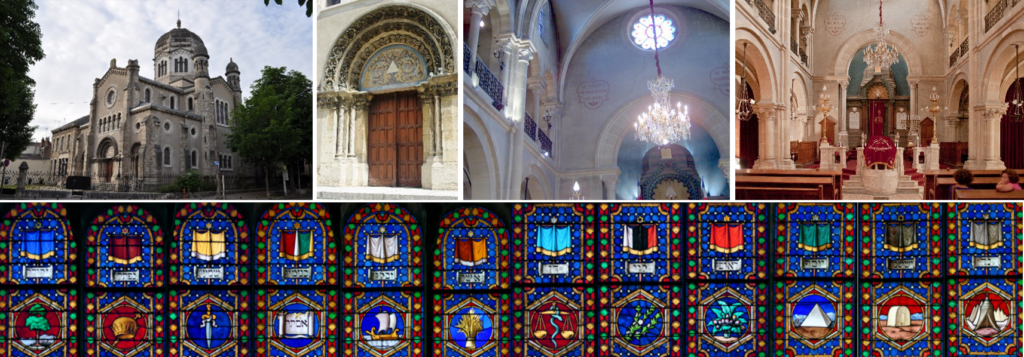
1879
Matot (מטות – Tribes), Numbers 30:2-32:42 .
[…]
2 tribes of the children of Israel, in these terms […]
The Ed Kahn Foundation Synagogue which is located across the street from Rabbi Elie Cyper[1] in Dijon a was built in 1879. It is located in a district[2] where the Jewish presence has been attested since the XIIth century. In 1394, the Jews were expelled from the city and would not return until after the French Revolution.
Appointed in January 1939 rabbi of the Community of Dijon, Elie Cyper was mobilized nine months later as captain-chaplain. He was taken prisoner in May 1940, but he immediately escaped. He resumed service as chaplain until his demobilization in August 1940. He then became the rabbi of the refugees. During the occupation of Dijon by the Germans (1940-1944), Canon Felix Kir[3], so municipal councilor has the synagogue transformed into a clothing warehouse to avoid its destruction and warns Rabbi Elie Cyper to save the objects of worship. From May 1943, Elie Cyper was active in the resistance group Combat[4]. He was arrested by the Gestapo on April 8, 1944, the first day of the Passover holiday. He was deported and assassinated by the Nazis in Kovno, Lithuania-Estonia, at the age of 35, on May 15, 1944. The population of Dijon and networks of smugglers allowed half of the Jews of Dijon, in particular the wife of the Rabbi Cyper and his 2 daughters to escape deportation.
The Dijon synagogue is listed in the Supplementary Inventory of Historic Monuments (March 15, 1989). In neo-Byzantine style, the building, the work of the Dijon architect Alfred Sirodot[5], is composed of ‘a central nave and two aisles, interrupted by a transept with two small turrets. The choir is topped with an octagonal cupola. The decorative ornaments were made by Jules Schanovki (sculptures), Léon Leniept (paintings) and Eugène Oudinot[6] (stained glass, especially those symbolizing the twelve tribes).
[1] Elie Cyper was born in Ukraine in 1908. He was decorated with the Croix de Guerre 1939-1945, the Medal of the French Resistance and the Medal of the Order of the Liberation.
[2] The streets of Petite-Juiverie where there was a synagogue (currently rue Piron), of Jews (rue Buffon) and of Grande-Juiverie (rue Charrue) .
[3] Félix Kir (1876-1968) priest, politician and resistance fighter (Commander of the Legion d’Honneur, Croix de Guerre 1914-1918 and 1939-1945, Medal of the French Resistance, etc.), he gave his name to a cocktail recipe based on Aligoté white wine (lively and fresh wine) and crème de cassis. When he went to the Assembly, he carried a bag containing the necessary to make kirs that he offered to his companions.
[ 4] The most important of the eight great French Resistance movements created by Henri Frenay (Henri Frenay Sandoval, 1905-1988) and Berty Albrecht (born Berthe Pauline Mariette Wild, in 1893 in Marseilles and died on May 31, 1943 at Fresnes prison).
[5] Philippe Auguste Alfred Sirodot (1831-1900) .
[6] Eugène-Stanislas Oudinot de La Faverie, known as Eugène Oudinot (1827-1889), is a French glass painter. He also made